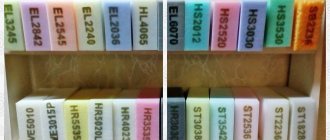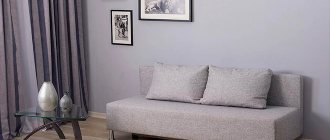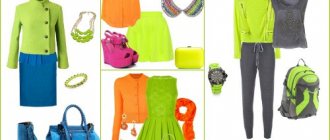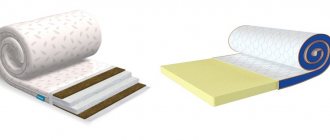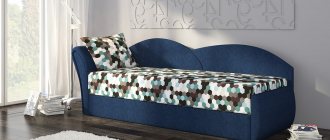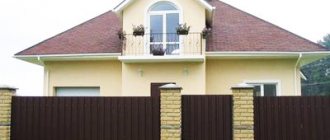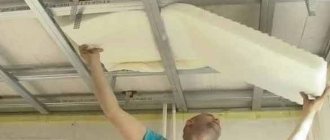This is polyurethane foam - a plastic foam that is 90% air. The material began to be called this way in Soviet times, after the name of the Norwegian supplier Porolon.
The first foam rubber appeared in Germany in 1941, when they studied the foam that is obtained in the manufacture of hard plastic. At first, foam formation was considered a negative process because it prevented the production of dense polyurethane without air. Then they figured out how to benefit from the negative process. Since 1954, the Bayer company began producing foam rubber for stuffing furniture and toys, insulation, making sponges, and as packaging material.
The first foam rubber was short-lived - it quickly lost its elasticity, crumbled - and easily ignited. Now they add special mixtures that prevent ignition.
Foam rubber brands
Defined by three properties:
1. Density - the amount of polyurethane in one cubic meter.
2. Stiffness - the force required to compress the foam by 40%.
3. Residual deformation - the ability of foam rubber to retain its shape. The material is placed in conditions of the desired temperature and humidity, compressed by 50% and measured to what extent the material has deviated from its original shape.
The letters indicate the type of material, and the first two numbers after the letters are the density, the second are the hardness.
For stuffing furniture armrests, seats, headrests
HS - soft and super soft
For sponges, rollers
For seats, mattresses
HR - highly elastic, with added latex
For high quality furniture, orthopedic mattresses
LR - soft, elastic. Distributes the load over the entire plane
In medicine for burn pads
RTC - reticulated (open cell)
For the manufacture of filters, ear pads, sponges, rollers
Hard foam rubber with a density of 40 kg per m3 and a hardness of 65 newtons per meter
What you need to know about foam rubber.
HOW IS IT MADE?
Foam rubber (more correctly - soft polyurethane foam, PUF) is produced in the form of blocks
(
block
) or various
forms
(the so-called
molded
PUF, when the foam is poured into special molds).
Block foam rubber, followed by cutting on contour cutting machines in the form of parts, is better in its physical and mechanical properties than its molded counterparts. In addition, parts made of block foam “breathe”, and molded products are covered with a crust that does not allow air to pass through.
Molded products are more economical and can have different geometries, while contour cutting machines do not allow cutting parts of any shape from block foam rubber.
From the point of view of chemical components, foam rubber can be made from simple and polyesters. The latter cannot be used for the production of upholstered furniture, since it is destroyed by moisture.
Currently, foam rubber is produced in a batch or continuous manner. The periodic, or so-called “box” method has a 50-year history and involves pouring a portion of foam into a box, the side walls of which, after raising the foam (like yeast dough), open. The resulting blocks differ from each other in their properties and have, compared to continuous ones, worse quality indicators.
In a continuous production method, the formed foam moves along a conveyor. This allows you to produce blocks of various lengths up to 60 meters. The block is homogeneous in its properties; Only the starting part of the block may differ - the first 1.5 m of length.
MAIN QUALITY INDICATORS.
The physical and mechanical properties of foam rubber reflect the following characteristics: density, rigidity, air permeability, cell size, elasticity, residual deformation, tensile strength, relative elongation.
For highly elastic foams, two more indicators are used: support and comfort coefficients.
Density.
It is sometimes called apparent density, since the foam cells also contain air - the main characteristic that largely determines all the others. For example, if we are talking about standard foam rubber with a density of 25 kg/m3, then the compression stress will be in the range of 3.4-3.5 kPa. It is especially important that the period of use of foam rubber mainly depends on the density, and the higher it is, the longer the period of its use.
It must be borne in mind that the foam block is not uniform, so the density is measured at different points along the cut height, and then the average density is determined.
Compressive stress.
This value characterizes the rigidity of the foam rubber and shows, according to the international standard ISO 3386 DIN 5377, what force in kPa must be applied to the foam rubber sample in order to compress it by 40%.
Some manufacturers artificially increase the rigidity of foam rubber, deliberately using recipes for producing it with a semi-closed structure (such foam rubber is characterized by a crackling sound when pressed). However, after mechanical opening of the cells, due to pressure, the foam rubber acquires a natural lower rigidity.
Strength indicators.
These include tensile strength at break and elongation at break. The first shows the force, and the second shows the stretch that must be achieved for the sample to break. For standard foam rubber with a density of 25 kg/m3, these values are 120-140 kPa and 240-280%, respectively.
Elasticity.
The elasticity of foam rubber is determined by the height of the rebound of a special ball after it freely falls onto a sample of foam rubber from a certain height. Obviously, the stiffer the foam, the less elastic it is.
Residual deformation.
This is one of the most important indicators of the quality of foam rubber, characterizing its ability to maintain its size and shape during operation. To determine it, a sample of foam rubber is compressed by 50%, and in this state it remains for a certain time at a certain temperature and humidity of the surrounding air. After the cessation of exposure, the sample’s deviation from its original dimensions is measured (in percentage). Obviously, foam rubber with high residual deformation cannot be used for making furniture seats. It is important to note that the higher the density of the foam rubber, the less its residual deformation.
Comfort indicators.
Their use is an indicator of the manufacturer’s very responsible approach to their products. These include the comfort factor and the support factor. The first characterizes the pleasant touch and softness of the foam rubber with low compression, and the support coefficient is the ability of the foam rubber to better hold and distribute the force caused by a large load placed on top.
Comfort factor = force at 20% compression (kPa)/force at 5% compression.
Support ratio = force at 65% compression/force at 25% compression.
The higher the comfort indicators, the better the foam. These indicators are usually used for highly elastic brands of foam rubber.
TYPES OF FOAM.
In the production of furniture and mattresses, the following types of foam rubber are used: standard, high-hardness and hard, soft, super-soft, highly elastic, special (non-flammable and viscoelastic).
Standard grades (ST) are produced on the basis of one, so-called standard polyol. Their rigidity is entirely determined by density. For other types, at least two types of polyol are used. By changing the ratio of the components in the formulation, a wide range of materials with different properties can be obtained.
High-strength (EL) or hard (HL) foam rubber is produced using special types of polyols. Soft and supersoft grades of foam rubber (HS) are obtained by using a special polyol instead of the standard one or in addition to the standard one. Highly elastic grades (HR) are produced only on the basis of special polyols, and a combination of two or three is usually used.
In the process of producing highly elastic foam, the resulting blocks (as well as molded products) must be rolled on a special machine after 24 hours to open the closed cells.
Non-flammable grades are obtained using special melamine powder, Bayer PHD polyols or special additives - fire retardants. Melamine gives better fire resistance results, but its use worsens the physical and mechanical properties of foam rubber.
Viscoelastic foam rubber brands have recently found widespread use in the mattress industry. To obtain them, not only special polyols are required, but also special isocyanates.
Foam rubber is marked by type, density and hardness (for example, brand EL2540 means: high-hardness foam rubber, density - 25 kg/m3, hardness - 4 kPa).
Standard brands in the world are now gradually being replaced by brands with improved characteristics. But in our market the standard still occupies a dominant position.
It is important to remember that foam rubber with a density of 25 kg/m3 and lower in Europe is used as packaging material, while in the CIS market it predominates and is often used by furniture makers.
For backrests, armrests and headrests, standard foam rubber with a density of 25-30 kg/m3 can be used, and for seats and mattresses, material with a density higher than 30 kg/m3 can be used.
High-rigidity foam rubber with a density of 25-30 kg/m3, in contrast to standard brands, can be used in the manufacture of seats and mattresses, taking into account the planned loads on them (from 60 to 80 kg). With a density over 30 kg/m3, there are no restrictions on load, but it is better to use such foam rubber in combination with softening flooring from HS grades.
One important remark cannot be avoided here. The fact is that manufacturers of furniture and mattresses in the CIS countries usually receive foam rubber in packaged form, compressed by volume by 4-6 times. After unpacking and unrolling the roll, it significantly loses in quality (for example, high-quality foam rubber brand EL2540 after unrolling has a hardness of 3.2 kPa instead of 4 kPa, and low-quality foam is even less). Therefore, in Western European countries, foam rubber is not compressed during transportation.
Brands of soft and ultra-soft foam rubber (the most common are HS2520, HS3030, HS3530) are widely used for the manufacture of backrests in upholstered furniture and covering material for mattresses. In addition, HS3530 grade is independently used to make seats, and extra soft grades are used to make foam cushion covers.
Highly elastic foam rubber is used to make expensive furniture. To ensure maximum comfort for their products, manufacturers of upholstered furniture and mattresses often use the principle of multi-layering: as the top flooring layer they use a brand with a high comfort coefficient, and below a brand with a high support coefficient.
Despite the relative high cost, highly elastic grades are increasingly used every year: in France, their production has reached 30% of the total volume of foam rubber produced in the country.
Any furniture requires high-quality and optimal filling, be it a spring block that helps create reliable seats and sleeping areas, or soft filling for armrests and backrests. Not paying due attention to such materials means depriving yourself of the pleasure of using comfortable and beautiful furniture. To be confident that you are making the right choice among the abundance on the market, you must have at least a superficial understanding of this or that type of filler. So, let's talk about foam rubber or, as it is more accurately called, polyurethane foam. Often, among various types of furniture-related information, one encounters the name not only of foam rubber and polyurethane foam, but also the abbreviation of the latter - PPU. Essentially, all of this is the same thing. No matter how furniture experts call this material in their notes and articles, we are talking about foam rubber, which is well known to everyone. Another thing is that this filler, known even to a child, is not as simple as it seems. This is because it has a considerable variety of varieties and is characterized by a certain set of properties that can differ radically from each other. It is these properties that influence where and how it should be used.
Main characteristics of polyurethane foam as quality indicators
The properties of polyurethane foam, on which its physical and mechanical characteristics depend, include: density, rigidity, tensile strength, residual deformation, air permeability, elasticity, elongation, cell size, support and comfort coefficient. The last two values are used mainly for highly elastic grades of polyurethane foam. These indicators determine how long the polyurethane foam will be used, how comfortable a particular surface of a furniture product will be, and even how “breathable” a sleeping place created using a specific type of polyurethane foam will be. To get to the heart of the matter, let's look at a few key properties.
Density
Perhaps the most basic parameter, which largely determines all the others. The density of polyurethane foam also affects its service life. As a rule, the higher it is, the longer the PPU lasts. This is explained by the fact that due to the larger amount of substance per unit volume, brands with higher density do not lose their original size and rigidity so quickly; they are better able to withstand long-term static and dynamic loads. In simple terms, density is the amount of foam rubber per unit volume, i.e. a value indicating how many kilograms of polyurethane foam are per 1 cubic meter. It is often confused with rigidity, but this is not correct. Although these two indicators are interconnected, they are not as clear as it seems at first glance. Softer foam rubber can have even greater density than hard foam. However, in fairness, it should be noted that density still determines the lower and upper limits of PU foam rigidity, which can be achieved for a given density value within one foam class.
Rigidity
No less significant indicator. Stiffness is characterized by the value of the so-called “compressive stress” - it shows how much pressure must be applied to the foam in order to compress it by 40%. For soft furniture parts, types of foam rubber with the required stiffness value are selected, often taking into account the future load on the product.
Permanent deformation
This is also one of the key indicators of the quality of furniture foam rubber, allowing one to judge how well it is able to maintain its size and shape during use. To determine the value of this indicator, a test sample of polyurethane foam is compressed by 50% and left there for a certain time in a room with a specific temperature and humidity. After removing the load, determine, as a percentage, the amount of deviation of the sample from its original dimensions. It is clear that polyurethane foam with a high rate of residual deformation should not be used for the manufacture of sleeping surfaces and furniture seats.
Types or brands of foam rubber
In order not to make a mistake with your choice, and to choose the right filler for furniture, it is worth remembering that it is divided into certain brands. The list of these brands of polyurethane foam includes more than ten varieties, including special fireproof ones, for household use, and secondary foamed polyurethane foam. However, only about five species are especially widely used. We'll talk about them now.
Standard Grade (ST)
A simple brand, which is produced on the basis of one base polyol and is considered the “foundation” for other brands of polyurethane foam. It is marked, respectively, with the symbols - ST and is characterized by the dependence of rigidity on density. It is used both for packaging and creating decorative elements, and for the manufacture of backrests, armrests, headrests, as well as for seats and berths, taking into account the expected load.
Brand of hard foam rubber (HL) and foam rubber with increased rigidity (EL)
Produced using special types of polyols. In fact, this is a modification of the ST brand, which, with the same volume as it, has greater rigidity. It is often used to make mattresses and seats, selecting the required density and rigidity depending on the expected loads.
Soft and ultra-soft grades of foam rubber (HS)
This type of foam rubber is produced using a special polyol, which softens the foam. It is most widely used for the manufacture of furniture backs and as a covering layer for mattresses.
High elastic grade (HR)
Produced using two or three types of special polyols. This brand of polyurethane foam has a high level of comfort, which combines low initial rigidity and quite impressive load-bearing capacity. It is thanks to such unique properties that this brand of foam rubber is used for the manufacture of expensive, high-quality furniture as filling for sleeping places and seats.
Any polyurethane foam is usually labeled by type, density and hardness. For example, ST3542 means: standard foam rubber, density - 35 kg/m3, hardness - 4.2 kPa. In conclusion, I would like to note a few more nuances. It is also important not to forget that polyurethane foam with a density below 25 kg/m3 has long been used everywhere exclusively as packaging material, and therefore, when using it in the manufacture of furniture, one should not expect high levels of comfort and durability. It would not be amiss to mention the principle of multi-layering, which is often used by manufacturers of high-quality furniture: on the bottom they use a brand of polyurethane foam with a high coefficient of support, and on top - as a flooring, a brand with a high coefficient of comfort. In a word, no matter what you have in mind and no matter what furniture dreams you decide to bring to life, taking into account the above-mentioned “simple truths”, it will be much easier to implement your plans. The main thing is desire and imagination, and the “right” polyurethane foam will not keep you waiting!
Foam rubber is the trade name for sheet polyurethane foam (abbreviated as PPU). Foam rubber, which is used in furniture production and in the manufacture of mattresses, is made on the basis of polyesters. Foam rubber produced on the basis of polyesters cannot be used as a filler for mattresses or in the production of upholstered furniture, since it quickly collapses under the influence of moisture.
Foam rubber is currently produced in a continuous manner at most enterprises. The periodic or “box” method is currently practically not used. With the batch method, a pre-prepared and thoroughly mixed composition is poured into a box, then, after the foam has risen (similar to yeast dough), the side walls of the box are removed. The blocks obtained by the periodic method differ markedly in their properties and, compared to foam rubber obtained by the continuous method, have worse quality indicators. The foam obtained using the continuous method is more homogeneous; the length of the workpiece can reach 60 meters, which is impossible with the box method, while only the initial (starting) part of the block differs in homogeneity.
One of the most important indicators of high-quality foam rubber is the coefficient of residual deformation
. This indicator characterizes the ability of foam rubber to maintain the dimensions and shape originally specified for the product during long-term use. The residual deformation coefficient is determined by compressing the sample by 50%, then, after a certain time, the load is removed. After restoration, the deviation (in percentage) from the original size is measured. Foam rubber with a high coefficient of residual deformation cannot be used in the manufacture of mattresses and upholstered furniture seats.
Density
, or more correctly, apparent density, since the foam cells contain air, is also one of the main parameters that largely determines other characteristics. In foam rubber with a density of 25 kg/m3, the compression stress (one of the comfort indicators) will be in the range of 3.4-3.5 kPa. It is the density that mainly determines the service life of foam rubber. With a higher density, foam rubber will last longer.
Rigidity.
Sometimes manufacturers artificially increase the rigidity of foam rubber, intentionally using recipes in production to obtain cells with a semi-closed structure. When compressing foam rubber with a semi-closed cell structure, a cracking sound is heard. After mechanical destruction of the cells, due to repeated compression, the rigidity of the foam rubber decreases. The rigidity decreases noticeably after transporting foam rubber in compressed form in rolls.
Durability of foam rubber.
This characteristic is determined by two indicators: tensile strength and elongation at break. Tensile strength measures the force that must be applied to a test piece for it to break. Elongation determines the stretch required to break the sample.
Elasticity of foam rubber
is determined simply. A special ball falls onto the sample from a certain height, the rebound height of which determines the elasticity index. Obviously, stiffer brands of foam are less elastic.
The following brands of foam rubber are used in the production of upholstered furniture:
HS - super soft foam rubber brands
used as packaging material or in the backs and armrests of sofas.
S - soft grades of foam rubber
, as well as super-soft ones, are used in those parts of upholstered furniture that are not subject to heavy loads.
ST - standard brands of foam rubber
can be used in the production of upholstered furniture, including seats, but preferably with a density of at least 30 kg/m3.
EL - brands of foam rubber of increased rigidity
, just like ST, are used for the seats of armchairs and sofas.
HR - highly elastic brands of foam rubber
are also often called latex foam rubber, and sometimes artificial latex.
Highly elastic foam rubber is used in expensive models of upholstered furniture. VE - viscoelastic foam rubber brands
are widely used in the production of high-quality mattresses. Despite the high cost, highly elastic foam rubber is increasingly replacing cheaper brands every year.
In order to visually distinguish different brands of foam rubber, various dyes are added to the composition during production.
5 year warranty!
Free visit of a measurer
Only high quality material!
12 years of experience!
Some construction companies suggest using a new, much more effective material - polyurethane foam - instead of old, outdated foam rubber as a heat insulator. Experts explain in detail how polyurethane foam differs from foam rubber, and what advantages this modern insulation offers. Is this a fair comparison?
Types of foam rubber
Leaf - rectangular in shape, 5–1000 millimeters thick. Suitable for thermal insulation.
Rolled - of different widths and thickness up to 30 millimeters. May be lined with fabric or synthetic materials. Suitable for lining furniture upholstery, car seats, and thermal insulation.
Block (molding) - different shapes. Used for toys, rollers and sponges, packaging fragile items.
Acoustic - with and without relief. Needed for sound insulation.
Acoustic foam rubber with relief
White foam rubber turns yellow from the sun, but does not lose its qualities - if possible, cover it with material that does not transmit ultraviolet radiation.
Alexandra Timochkina Author of the article
Alexandra Timochkina Author of the article
In modern production of upholstered furniture it is almost impossible to get by. But here the obvious question arises, what is better, foam rubber or without the use of foam rubber.
Polyurethane foam? Many people say that polyurethane foam (PPU) is better, they say it has a “crust” thanks to which it lasts longer and is harder to the touch, but we dare to disappoint you, both foam rubber and polyurethane foam are the names of the same product. Its correct name is certainly polyurethane foam, and the name foam rubber stuck to it quite a long time ago, back in the 50s, when the only supplier of polyurethane foam was. But now all this is long in the past and it is much more convenient for us to call foam rubber foam rubber.
Now on the Russian market there are quite a lot of companies involved in the production of foam rubber, but they mainly produce lightweight foam rubber, the density of which is less than 25 kg/m3. This type of foam is much easier to produce and transport. But it cannot be classified as furniture. The World Association recognizes foam rubber as furniture if its density is not lower than 25 kg/m3. Foam rubber of lower density is classified as soundproofing or packaging, although it can also be used to create elements of upholstered furniture that are not subject to stress. You can buy furniture foam rubber in Moscow from one sheet in our online store.
Density matters!
Recycled polyurethane foam varies in density and can be of different thicknesses. If we are talking about a sports mat for professional gymnastics, it is better to buy foam rubber for mats with a density of 80 kg/m3. And for tatami, experts advise choosing a filler whose density is at least 140 kg/m3. It is, of course, more expensive, but it is more convenient to train on it. If you need to save money, you can use a compromise solution - purchase filler of different densities for the fight zone (PVV-140 brand) and the safety zone (PVV-100 brand).
PVV-140
from 449 rub. per sheet
Go
Which one is used?
The material is used in a variety of fields and selected for different needs according to certain characteristics. For mattresses, the density of foam rubber is important; the service life of the product depends on it. They use polyurethane foam with a density of 25 to 40 kg/m3. The density is indicated by two numbers after the two letters in the name, the next two numbers indicate the hardness index.
Mattresses are made from the following types of foam rubber:
- Standard PPU . The brand is designated ST.
With increased rigidity. Its designation is EL. A popular suggestion is the EL2240 brand. This is a budget option; you shouldn’t expect longevity from such a mattress; it will only last about five years. The EL2540 will last a couple of years longer, but the EL2842 can remain in good condition for ten years.
- The brands HR and VE denote latex foam; such foam is used for sofas and other luxury furniture. You can purchase such foam rubber for furniture at Leroy Merlin. This type of foam is also used in thin orthopedic sofa mattresses.
What density is there: marking
Each type of polyurethane foam has its own brand. This is necessary to select the optimal filler for a particular case. There are more than a dozen such brands in total, and they include special fireproof, secondary foam, etc.
But, in furniture and household production, much fewer models are used. So, how to find out the foam model by marking?
(ST) – standard
Material produced on the basis of standard polyol. Refers to the basic type, for creating other PPU models. Designated "ST".
Material used to create:
- Elements of interior decoration;
- Chairs, armchairs, headboards for them;
- Upholstered furniture;
- Decorative walls;
- Armrests, headrests.
- Due to its low cost, standard polyurethane foam is used in a wide variety of industries - from handicrafts to insulation of building facades.
(HL) - hard, and (EL) - the hardest foam rubber
They are made on the basis of special types of polyols - viscous white suspensions. In simple words, EL and HL are ST modifications that have increased rigidity, but are identical in volume and other characteristics.
The hardest and most rigid polyurethane foams are used in the production of seats and mattresses, which are selected according to the expected levels of future load.
(HS) – soft, ultra-soft
The base is a special polyol that makes the foam as soft as possible. It is used for arranging backrests and as a mattress bedding layer.
(HR) – increased elasticity
Includes several types of foam rubber. The brand is one of the most comfortable, combining low rigidity and a high level of wear resistance. Used in factories producing luxury, expensive furniture and top quality mattresses.
Each variety is labeled by brand, density, and hardness. For example, HR4582 means that the foam rubber has increased elasticity, density – 45 kg/m. cubic meters, hardness – 8.2 kPa.
Good to know!
Polyurethane foam with a density of less than 25 kg/m. cube has not been used in production for a long time. It is used as packaging material. That is, the higher the density, the better, more durable, and stronger the material. It is worth remembering the principle of multi-layering. Modern furniture manufacturers always use polyurethane foam with increased support characteristics on the bottom, and a model that provides the greatest comfort on top.
Damage to foam mattresses
Are there any health risks from polyurethane foam mattresses? Foam mattresses have been made for decades, and the controversy over their harmfulness will not subside. And there are reasons for these disputes: synthetic “origin” and low orthopedic properties. Reviews of polyurethane foam mattresses can be found here.
The material is made from synthetic components. They emit volatile substances with an unpleasant “chemical” odor. And some cheap models, manufactured in violation of technology, retain it for a long time, or even the smell does not disappear at all. The substances released are hazardous to health, just like those released when a mattress burns. But it has not been proven how harmful the released substances are in minimal quantities.
The video shows the density of foam rubber for a mattress:
Harm has not been proven, so polyurethane is the most common material for the production of mattresses.
Its advantages contribute to this:
- Doesn't burn on its own. Combustion is supported by another source of fire.
- Quickly restores its shape.
- Affordable for many.
- Low thermal conductivity.
- Vapor-tight.
- Waterproof.
- Easy to transport.
- Easy to care for.
The harm of foam mattresses also lies in their low orthopedic properties. Doctors insist that the sleeping place should be quite hard. Therefore, mattresses are equipped with an independent block of springs, a layer of coconut coir and other “devices”. And the usual foam version is often soft, bends greatly, which leads to curvature of the spine. The body does not always rest well on soft things; in the morning there may be numbness in the limbs, muscle stiffness, and tingling in them. The result, at a minimum, is poor health and a bad mood. And the maximum is problems with the spine.
What is the composition of the Asonia pillow?
How to choose an orthopedic neck pillow?
Kinds
Foam mattresses are divided into types depending on the degree of rigidity of the products:
- Soft.
Reminiscent of a cozy downy feather bed. Comfortable, but harmful to the spine. - Medium hardness
. They restore their shape quite quickly and provide normal support to the spine. - Tough
. These are orthopedic mattresses; their rigidity is provided by additional components (coconut coir or independent springs).
Highly elastic elastic foam is used for the mattress. It is also called artificial latex or latex foam rubber.
Dimensions
The size of the mattress must match the size of the sleeping area.
There may be significant differences in the size of products from different manufacturers. For example, in the USA it is customary to indicate the dimensions of mattresses in inches. An American mattress will not be suitable for beds made according to European standards. Hence the recommendation: choose a mattress and bed from the same country of origin, and ideally from the same manufacturer.
Mattresses are produced for children and adults. But what size should a standard mattress be? The standard sizes of a double mattress for adults are of two types in length: 190 and 200 cm. The size of a mattress for a single bed in width is 70 or 90 cm. The size of a 1.5 double bed is 120 cm. Depending on the size, it is suitable for a “double bed” mattress 140 x 200 or 200 x 200. The dimensions of one-and-a-half sheets for the bed can be found here.
Non-standard mattresses are made to order according to the required dimensions.
How to do it yourself?
Everyone needs a new mattress from time to time. And many people can do it themselves. This could be an option for the dacha. And it happens that the fabric on the mattress is still good, but the foam has already sagged.
You will need:
- Foam rubber.
- Mattress cover material.
- Felt.
- Glue for foam rubber.
If the spring blocks are in good condition, then it is enough to replace only the pieces of foam rubber with new parts.
Work algorithm:
- Lay foam rubber on the floor and cover it with felt.
- Glue pieces of foam rubber to the sides to hide the springs.
- On top, when the glue dries, put felt, and then foam rubber.
- The final step is to insert the foam into the case.
If you need a new mattress without springs, you first need to decide on its size. Purchase foam rubber with the required parameters. Then sew a mattress cover. When cutting, take seam allowances into account. All that remains is to place the polyurethane foam in the case.
Video of a DIY foam mattress:
Features of choice
It is best to rest on a soft and elastic mattress. It will allow you to completely relax after a hard day. This should be understood when choosing foam rubber for furniture. To achieve this effect, manufacturers create a special layered structure of the pillow. The top layer consists of thin and not too dense foam rubber. Then comes a harder and more elastic layer of material.
Of course, in addition to foam rubber, the quality of the spring blocks that are in your sofa is important. Well, they also use padding polyester to create a high-quality filling. This synthetic material serves to create an insulation system for the base layer and its additional compaction.
In high-quality branded sofas, foam rubber from an elastic material or natural latex is used to create the filling.
Many people believe that the orthopedic effect can only be achieved by using spring mattresses. But the use of low-quality materials can completely negate this statement. In addition, to get a reliable and comfortable sofa, you need to put several layers of felt or other materials on the springs to create an even and soft covering. This is quite expensive, and in some cases it is better to use good foam rubber instead of poor quality springs.
Manufacturers, cost of products
Attention! When choosing a mattress, carefully study the reviews on the forums!
- ORMATEK. Enterprise in the Ivanovo region. Ormatek is a worthy competitor to well-known brands. The cost of a mattress for a “single bed” is 7,000 rubles. Again, it’s cheaper to buy on sale.
